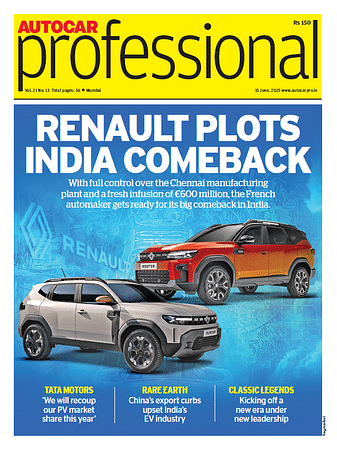‘We must make roles gender agnostic': Shradha Suri Marwah
The President of the Automotive Component Manufacturers Association of India (ACMA) and Chairperson of leading Tier-1 major Subros believes competency, not gender, should be the parameter for any job in the industry. Interview by Mayank Dhingra.
Shradha Suri Marwah, President of the Automotive Component Manufacturers Association of India (ACMA) and Chairperson of leading Tier-1 major Subros believes competency, not gender, should be the parameter for any job in the industry.
What initiatives is ACMA taking to increase diversity within its member companies?
There are several initiatives that ACMA is taking right now. We are trying to look at diversity as whole, and going beyond gender. We have recently launched a pillar for DEI – diversity, equity, and inclusion – with a focus on creating awareness for our members on why diversity is important and how it leads to enhancement in innovation and productivity. It is a proven fact that diversity drives innovation and efficiency.
As ACMA, we are working with the entire value chain on how we can improve diversity in the automotive industry. It is a pity that diversity in the automotive sector currently averages 8%. But our endeavour is to double it to 15-16% and bring more women in the automotive workforce in the next five years.
ACMA has partnered the Bill and Melinda Gates Foundation and the Good Business Labs – wherein we are analysing individual ACMA member companies to understand where they stand in terms of diversity. The programme is jointly undertaking measures to increase women participation in the mid- and senior management roles, and not just at the entry level. While there is a lot of work that needs to be done, we are going to get there, and I am a testament to that.
We believe that if we can create success stories within ACMA members, we will be able to cascade that across the membership, the bulk of which is MSMEs, and we want to drive this agenda to them. We want to go beyond just checking a box when it comes to diversity in the workforce.
Are we going to see more women leaders in the automotive industry?
There is always a start and I do believe that there is a lot more women coming into leadership as entrepreneurs and even as the second generation within a family business. So, there is a shift in the mindset and on the professional space as well. The challenge, however, is that while we have a large pool of women at the entry level, they, somewhere whilst reaching the mid-level, drop off for some well-known reasons – marriage, children, etc. What I am keenly trying to work around is how to re-employ women after they have dropped off.
Once we have such return-to-work initiatives in place, we will see women climb up the ladder because the issue is not about lack of skills or abilities, it is about their presence in the workforce, in the first place. One must also allow the social fabric to take over and provide them with a support system. While some women have that advantage, many do not. But it should not be a deterrent at all.

We are also seeing a lot more diversity on the shopfloor rather than in other white-collared jobs but that is changing. While it is not as quick as it should be, people are talking about it. One of the biggest issues that we are facing is not from the women’s side, but, from the male perspective. It is the men who find it hard to embrace women as colleagues, and therefore, a lot more awareness is required on the male front. Today, women need to try too hard to stay where they are, or grow in an organisation, and this is particularly a bigger problem in the mid-management and white-collared roles.
Hence, we must make roles gender agnostic, and the most capable person – be it a male or female – must be the righteous owner of a specific job. Having said that, I do think that women do need flexibility because they tend to be the primary caregivers and hence, they need to balance, especially if they have children. Therefore, some sort of flexibility must be provided and we must focus on the deliverables rather than making them realise the fact that they have more benefits compared to men. It is not possible for a country like ours to ignore, what constitutes almost 48-50% of its population.
What is your vision for diversity at Subros?
Subros is a very interesting example, and we are already at 14-15% diversity ratio, which is where we desire to take the entire sector in the next five years, by when our aim is to take Subros to 30% diversity levels. Furthermore, our Board, which comprises 12 members, is 45% women. Therefore, Subros is quite an anomaly and we have some very powerful women on the Board. While I try to educate and drive this narrative in my own organisation, it is the same thing I would like to drive for ACMA as well. The entire membership needs to a
RELATED ARTICLES
'No Question of Us Being Late' - Suzuki India on e-2Wheeler Market
Suzuki Motorcycle India believes its EV entry is timely as the market is now mature enough to grow off genuine demand ra...
'India Can Become a Major Pillar for Us' - Marquardt Group
Björn Twiehaus, CEO of Marquardt Group, and Vishal Narvekar, the company's India GM, share their outlook on the Indian m...
Luxury Car Market to Slow in 2025: Mercedes-Benz Sees Flattish Numbers
In Jan to March of 2025, the market may witness its slowest growth since COVID-19, and if the weakness continues, the se...





 08 Mar 2025
08 Mar 2025
 10684 Views
10684 Views





 Angitha Suresh
Angitha Suresh


 Darshan Nakhwa
Darshan Nakhwa

 Prerna Lidhoo
Prerna Lidhoo

